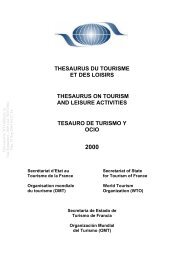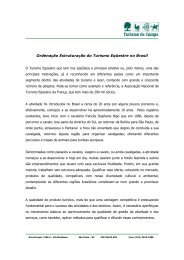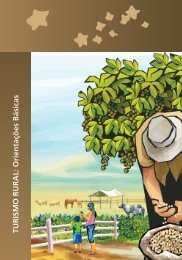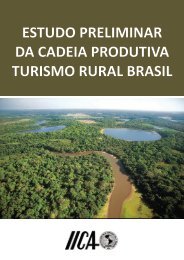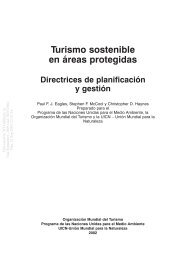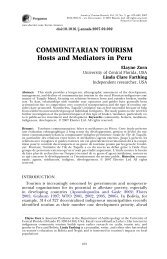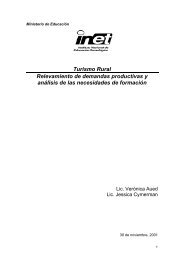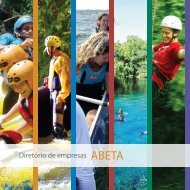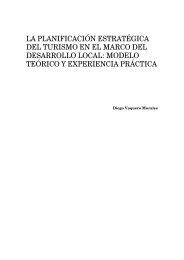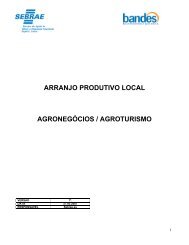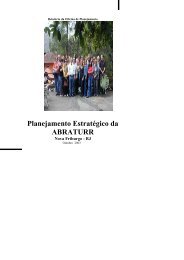TOURISM AND RURAL SETTLEMENTS Nepal's ... - ResearchGate
TOURISM AND RURAL SETTLEMENTS Nepal's ... - ResearchGate
TOURISM AND RURAL SETTLEMENTS Nepal's ... - ResearchGate
You also want an ePaper? Increase the reach of your titles
YUMPU automatically turns print PDFs into web optimized ePapers that Google loves.
Annals of Tourism Research, Vol. 34, No. 4, pp. 855–875, 2007<br />
0160-7383/$ - see front matter Ó 2007 Elsevier Ltd. All rights reserved.<br />
Printed in Great Britain<br />
www.elsevier.com/locate/atoures<br />
doi:10.1016/j.annals.2007.03.012<br />
<strong>TOURISM</strong> <strong>AND</strong> <strong>RURAL</strong> <strong>SETTLEMENTS</strong><br />
Nepal’s Annapurna Region<br />
Sanjay K. Nepal<br />
Texas A&M University, USA<br />
Abstract: Functional and humanist perspectives relevant to counterurbanization studies are<br />
applied to examine the processes of growth and development of rural settlements affected by<br />
tourism. Based on a survey of tourism lodges located in several settlements in the Annapurna<br />
region of Nepal, this paper analyzes tourism-induced growth in such accommodations and its<br />
implications on changing characteristics. Results suggest the emergence of a hierarchical<br />
structure of rural settlements with core and peripheral traits. A normative classification of<br />
induced patterns defined by their development stage, size, and function is proposed. Historical,<br />
social, and economic influences on the transformation of rural settlements are discussed.<br />
Keywords: counterurbanization, functional perspective, humanist perspective, lodges, rural<br />
settlements, normative classification. Ó 2007 Elsevier Ltd. All rights reserved.<br />
Résumé: Tourisme et zones résidentielles rurales: la région Annapurna au Népal. On applique<br />
des perspectives fonctionnelles et humanistes pertinentes aux études de la contre-urbanisation<br />
pour examiner les processus de croissance et de développement des zones<br />
résidentielles rurales affectées par le tourisme. Basée sur une enquête des gîtes de tourisme<br />
dans plusieurs zones résidentielles dans la région Annapurna du Népal, l’article analyse la<br />
croissance provoquée par le tourisme dans ce genre de logement et les implications pour<br />
les caractéristiques changeantes. Les résultats suggèrent l’émergence d’une structure hiérarchique<br />
des zones résidentielles rurales avec des caractéristiques fondamentales et périphériques.<br />
Une classification normative des modèles intentionnels selon leur étape de<br />
développement, ampleur et fonction est proposée. On discute des influences historiques,<br />
sociales et économiques sur la transformation des zones résidentielles rurales. Mots-clés: contre-urbanisation,<br />
perspective fonctionnelle, perspective humaniste, gîtes, zones résidentielles<br />
rurales, classification normative. Ó 2007 Elsevier Ltd. All rights reserved.<br />
INTRODUCTION<br />
Geographical perspectives on the patterns of development of tourism<br />
attractions and destinations have taken many different dimensions.<br />
Volumes have been written on the evolutionary models, including the<br />
widely popular lifecycle concept and its implications for destinations at<br />
each phase (Agarwal 2001; Butler 1980; Papatheodorou 2004). Traditional<br />
approaches to studying have included core and peripheral structures<br />
(Brown and Hall 2000; Christaller 1963; Zurick 1992), the<br />
Sanjay Nepal is Assistant Professor at the Department of Recreation, Park and Tourism<br />
Sciences at Texas A&M University, College Station TX 77845-2261. Email ).<br />
Trained in geography and planning, his research interests include the<br />
dynamics of conflicts between local communities and protected area agencies, participatory<br />
conservation of such areas, and environmental impacts of tourism. His current research focus<br />
is on impacts in mountainous regions of Canada, Nepal, and Thailand.<br />
855
856 <strong>RURAL</strong> <strong>SETTLEMENTS</strong><br />
morphology of attractions, destinations, and specialized resorts (Jansen-Verbeke<br />
1986; Leiper 1990; Pearce 1999), and the forms, functions,<br />
and expansion of resorts (Mathieson and Wall 1982; Pearce<br />
1978). More recently, the evolution of self-contained holiday villages<br />
and second homes is a topic of growing interest (Faché 1995; Hall<br />
and Müller 2004). However, Pearce (1999) has lamented that the spatial<br />
structure of tourism has essentially ignored processes and phenomena<br />
at localized scales. This well applies to rural regions, where at local<br />
and regional scales, the spatial arrangements of attractions have been<br />
researched very little. Moreover, studies on change in spatial characteristics<br />
of bucolic settings at both local and regional scales tend to be<br />
unsupported by extensive theoretical basis, as, Pearce (1995) asserts,<br />
has happened in the context of urban attractions. According to him,<br />
this requires drawing upon literature outside tourism: from the context<br />
of rural regions (the focus of this study), from rural studies, and particularly<br />
from research in counterurbanization.<br />
The changing relationships between urban and rural areas have<br />
been argued to be the products of restructuring and alignment of<br />
post-industrial production and consumption activities (Dahms and<br />
McComb 1999). These changes are manifested in the growth and redistribution<br />
of housing and settlement patterns (Kuentzel and Ramaswamy<br />
2005), and a realignment of bucolic space to accommodate the<br />
expanding service sector (Butler, Hall and Jenkins 1998). The interests<br />
in changing rural–urban relations have thus become a topic of<br />
renewed interest to many geographers, economists, sociologists, and<br />
urban and regional planners. Similarly, the spatial patterns of areal<br />
organization of settlements (Schnaiberg, Riera, Turner and Voss<br />
2002), and the evolution, appearance, and perceptions of regions’ distinctive<br />
cultural landscapes (Gude, Hansen, Rasker and Maxwell 2005)<br />
are topics of growing interest. Complementarily, a growing body of literature<br />
exists on counterurbanization and its effects on rural redistribution<br />
of population, housing, and changing patterns of human<br />
settlements (Dahms 1998). Counterurbanization has been defined at<br />
least in two ways: as a movement of people from urban to bucolic areas<br />
and as a change in settlement system (Mitchell 2004). One consequence<br />
of this phenomenon is that many areas are experiencing a transition<br />
from agrarian- to service-based industries, with dramatic effects<br />
on landscapes. While rural amenity attractions and touristic landscapes<br />
have been a topic of interests to many (Butler et al 1998), literature on<br />
tourism-induced settlement growth patterns and changing functional<br />
characteristics is scant. This paper aims to address this shortcoming.<br />
While counterurbanization studies are mainly concerned about the<br />
consequences of urban–rural movements, it is argued that the effects<br />
of international tourism in such destinations in the Third World are<br />
similar to that of counterurbanization effects in the developed West,<br />
where rural areas have seen rapid changes in their economy and settlement<br />
patterns. In the context of settlements, Mitchell has stated that<br />
the focus of counterurbanization studies shifts from ‘‘a migratory movement<br />
to one of a process of settlement system change...’’ (2004:18; italics<br />
in original). The emphasis on process implies that this must be exam-
SANJAY NEPAL 857<br />
ined from both functional and humanist perspectives. While the former<br />
offer explanations to how settlements evolve, expand, and take<br />
certain spatial and morphological forms (Cowie 1983), the latter enhance<br />
the understanding of complex social, political, and economic<br />
processes which influence the emergence and development of settlements<br />
(Spencer 1995). This study is about such processes, which are<br />
analyzed and explained through a combination of the functional<br />
and humanist perspectives, but in the context of tourism development.<br />
In particular, this study examines the processes of growth and distribution<br />
of accommodation lodges; the relationship between tourism infrastructure<br />
and settlement development patterns; the progression<br />
toward a hierarchical development and classification; and the historical<br />
and social factors in tourism-induced rural settlement development<br />
patterns.<br />
PERSPECTIVES TO <strong>RURAL</strong> <strong>SETTLEMENTS</strong><br />
Counterurbanization studies have progressed from their traditional<br />
functional view (forms, patterns, and shapes) to humanist interpretations<br />
of historical, political, social, and cultural factors that shape the<br />
arrangement and rearrangement of rural settlements systems. The<br />
functional perspectives have included the analysis of deconcentration<br />
of people and houses in bucolic areas, increase in number of dwellings,<br />
dispersal patterns of dwellings, areal differentiation, and hierarchical<br />
structures. The humanist perspectives have provided critical explanations<br />
as to why these patterns have emerged and in what ways people’s<br />
attitudes, decisionmaking behaviors, historical precedents, and political<br />
and social factors influence settlement patterns. The following<br />
review of the functional and humanist perspectives in counterurbanization<br />
studies attempts to illustrate their application to the processes of<br />
changes brought about by international tourism.<br />
Functional Perspectives<br />
While settlements have also been conceived as a product of adaptation<br />
to environmental conditions (Allen 1997), early research has focused<br />
on their role as central places, or as nodes of retail<br />
distribution. The classic spatial location theories of Christaller, Losch<br />
and Isard analyzed the size, spacing, and distribution of settlements<br />
as a result of their utilization of microeconomic theoretical principles<br />
(Harvey 1969 cited in Cowie 1983). Cowie (1983) argues that original<br />
central place theory has avoided the conceptual problems posed by the<br />
geographic characteristics of rural regions by incorporating these<br />
nodes into its assumptions. The classic models thus offer limited explanations<br />
to assessing the spatial characteristics of the very smallest settlements,<br />
or as what Haggett (1965 cited in Cowie 1983) has referred to as<br />
the lower limb. Similarly, Cowie (1983) argues that studies which have<br />
attempted to apply concepts compatible with classical analysis to
858 <strong>RURAL</strong> <strong>SETTLEMENTS</strong><br />
low-order areas have not considered the influence of political, social,<br />
and cultural forces on their size, shape, and distribution.<br />
Critics of spatial location theories have considered counterurbanization<br />
as a valid alternative that more appropriately explains the growth<br />
and change in population and settlement patterns in the lower hierarchies<br />
(Dahms and McComb 1999; Spencer 1995). A primary consideration<br />
of counterurbanization includes the deconcentration of people<br />
from cities to rural areas (Berry 1976), taking the form of an inverse<br />
relationship between the population size and its rate of growth (Champion<br />
1989). For many researchers, it is simply an issue of human migration<br />
from denser cities to peripheral and rural settings where the<br />
abundance of land is a primary attraction (Stockdale, Findlay and Short<br />
2000). Still others define it as some aspects of change in the settlement<br />
system, from densely compacted urban systems to deconcentrated patterns,<br />
where the scale and the spatial unit is at a much lower hierarchy<br />
(Spencer 1995). Mitchell (2004) states that counterurbanization is<br />
viewed as a process of change giving rise to a deconcentrated settlement,<br />
and raises the question of whether it should be construed as a<br />
movement, a process, or a pattern. Explanations as to what triggers<br />
counterurbanization are numerous: structural changes in national<br />
and international economies (Bolton and Chalkey 1990), attraction factors<br />
such as environmental amenities (Shumway and Otterstrom 2001),<br />
appeal of better environment and a tranquil lifestyle (Halliday and<br />
Coombes 1995), place utility (Sant and Simmons 1993), the rising<br />
importance of service sectors rather than manufacturing (Frey 1993),<br />
and commodification of rurality (Grieve and Tonts 1996). One significant<br />
process, which has intensified after the 90s, is the rise in demand<br />
for tourism and amenity migration in rural and countryside areas (Hall<br />
and Müller 2004). This demand has fuelled a rural service industry that<br />
continues to shape and reshape rural landscapes, land uses, housing<br />
and mobility patterns, and production of a countryside that is increasingly<br />
looking urban in character and sophistication. The effects of<br />
counterurbanization include permanent movement of people away<br />
from urban cities, contributing to the increase in number of rural dwellings,<br />
their dispersal patterns, areal differentiation, and the emergence<br />
of hierarchical deconcentrated settlement systems (Spencer 1995).<br />
These effects are similar to the effects of tourist flows in rural regions<br />
where despite the temporary nature of the surge, the number of permanent<br />
dwellings continues to increase. The new dwellings are either second<br />
homes or tourism accommodations. This increase in this housing<br />
and related infrastructure has produced settlement patterns that are<br />
dominated by tourism development. However, this phenomenon has<br />
not been studied well. Not much is known about the underlying processes<br />
and outcomes of the resulting growth and distribution patterns.<br />
Humanist Perspectives<br />
Three underlying themes that provide humanist perspectives on<br />
counterurbanization studies include change, process, and space.
SANJAY NEPAL 859<br />
Brown (1999) has argued that change as a research topic should exist<br />
in its own right. The analysis of tourism-induced rural housing and settlements<br />
thus can be viewed from the perspective of change, which is<br />
associated with processes or vice versa. Orjan (1999) has stated that a<br />
proper understanding of the recent past is essential to comprehend<br />
emerging patterns and processes. Inherent in these processes are a<br />
multitude of decisionmaking behaviors of various actors, resulting in<br />
a highly complex characterization of development process (Brown<br />
1981), largely attributed to the interaction among social and economic<br />
activities, physical ecological units, and development plans carried out<br />
in any given region. This interface, although nonlinear and dynamic,<br />
often produces a self-organized system. Historically, this has been the<br />
case for urban growth processes (Allen 1997), and today it can be related<br />
to growth processes in rural areas too. Cowie’s (1983) critique<br />
that the classic central place theories do not consider the political,<br />
social, and cultural factors in growth processes is a valid one. However,<br />
there is a growing body of literature that incorporates humanistic perspectives<br />
of development processes, for example, the changing functional<br />
roles of bucolic settlements as influenced by perceptions and<br />
decisionmaking by inhabitants (Spencer 1995). In the context of tourism,<br />
Butler and Clark (1992) also have argued for more systematic and<br />
indepth research on the relationship between the uneven social composition<br />
of rural areas, the spatially variable development of tourism,<br />
and the problematic relationship between the two.<br />
A second underlying theme is that of process, a sequence of changes<br />
in space and time (Cheng and Masser 2004). An understanding of<br />
change through both time and space should theoretically lead to an improved<br />
understanding of change and of the processes driving it (Gregory<br />
2002). A spatial process, however, is much more than a sequence of<br />
changes, and implies a logical sequence of events being carried out in<br />
some definite manner that lead to a recognizable result (Getis and<br />
Boots 1978). Change is defined by a series of patterns, and logical sequence<br />
implies an understanding of process. In contrast to pattern, process<br />
contains a dynamic component. In the context of rural settlements,<br />
it is imperative that both change and its processes are determined so<br />
that any undesirable alterations and processes therein can be minimized<br />
in the future. A third underlying theme is that of touristic space.<br />
The transformation of space often comprises complex, intertwined linkages<br />
of social, economic, and political space, as Torres and Momsen<br />
(2005) discuss in their study of Cancun, Mexico. Space can be differentiated<br />
in many ways: as an empty area which is merely a nonplace notion<br />
of placelessness, as an in-between tourism place where lines are blurred<br />
between travelling, dwelling, and other social behaviors, as an enclavic<br />
exclusively for the consumption of a tourism class (Place 1995), and as a<br />
hybrid development marked by irregularities (Torres and Momsen<br />
2005). The effects of tourism on space thus greatly vary across a region,<br />
producing a variable mosaic of space and landscapes.<br />
The discussion of functional and humanist perspectives is applied in<br />
this study of tourism-induced changes in the form, functions, and hierarchies<br />
of rural settlements in Nepal’s Annapurna region. Analysis is
860 <strong>RURAL</strong> <strong>SETTLEMENTS</strong><br />
based on two key questions: whether tourism-induced rural settlement<br />
systems exhibit patterns similar to the effects (growth, distribution,<br />
hierarchy) of counterurbanization and whether these effects can be<br />
meaningfully interpreted using humanist perspectives of change and<br />
processes discussed in the context of counterurbanization.<br />
Study Methods<br />
Results presented in this paper are based mainly on a questionnaire<br />
survey of 497 lodge owners, locally available documents on economic<br />
development trends, and published accounts of social and economic<br />
conditions in the region. Fieldwork, conducted during the four<br />
months between May and August 2002, included visiting 100% of the<br />
lodging establishments in 94 settlements. Onsite interviews with owners<br />
were conducted using a checklist of items which solicited information<br />
on the name of the property, location (including altitude), year of<br />
establishment, type of settlement, history of construction (i.e., new<br />
construction mainly for the purpose to use as a lodge or conversion<br />
of a pre-existing dwelling to one). Further, sought information included<br />
number of single, double, triple rooms, and dormitories, total<br />
number of beds, average room occupancy, number and type of toilets<br />
(attached/detached) and shower rooms (hot shower or not), and future<br />
plans for expansion. The checklist also contained information<br />
on owners’ primary and secondary occupation, ethnicity, approximate<br />
number of guests per day during tourism seasons (March–May and<br />
October–November), ownership information (own/rent), and number<br />
of employees (including hired labor from outside the family). Additional<br />
data were gathered through discussion with local people and<br />
other key informants, including local officials, schoolteachers, trekking<br />
guides, and porters. Informal conversations with guests, especially<br />
repeaters, were also useful in examining some of the changes. Because<br />
socioeconomic information on each village where the lodges were located<br />
was necessary to provide adequate context for development<br />
through time, secondary information sources (mostly in Nepali) were<br />
collected from five local administrative district headquarters in Pokhara,<br />
Beni, Jomsom, Chame, and Besisahar. Historical accounts of<br />
trade and tourism and other aspects of social and economic systems<br />
in the region are based on existing literature.<br />
A second purpose of the survey was to apply a normative classification<br />
scheme to the various types of settlements influenced by tourism.<br />
This was based on settlement records (old or new), history of lodges,<br />
number of lodges and their sizes (rooms and beds), type of economic<br />
function (degree of dependency on tourism or agriculture), degree of<br />
local involvement in tourism, and locational advantages (from a tourism<br />
standpoint) of the settlements. Based on the above and additional<br />
background information related to this history, demographics, and<br />
economics, a five-class system of settlements was developed. After analyzing<br />
the data, all were assigned to a class based on the above criteria<br />
and after cross-checking existing backgrounds available. The validity of
SANJAY NEPAL 861<br />
Figure 1. Major Settlements in the Annapurna Region<br />
the classification system was checked in two ways: one, correlations tests<br />
to examine if older settlements had proportionately more lodges and<br />
local employment in tourism compared to newer ones, and two, the<br />
fit of the classification was verified qualitatively from discussions with<br />
local lodge owners and key informants during a follow-up visit in summer<br />
2003. Data were coded and entered into the SPSS database (SPSS<br />
v. 12.0). Results are mainly descriptive, with the intention to provide an<br />
analysis of key processes of tourism-induced growth and distribution,<br />
and changes in settlement functions. Where appropriate, the results<br />
of Pearson’s chi square (X 2 ) and correlation (r) tests are discussed. Reported<br />
significance values are at a 0.05, unless otherwise indicated.<br />
Tourism and Rural Settlements in Annapurna<br />
Located in the western region of Nepal, the Annapurna Conservation<br />
Area is the most popular international trekking destination in this<br />
country (Figure 1). Its 7,629 km 2 area consists of high mountain scenery,<br />
more than 300 km of trail network through high passes, deep
862 <strong>RURAL</strong> <strong>SETTLEMENTS</strong><br />
Number of Permits ('000)<br />
90<br />
80<br />
70<br />
60<br />
50<br />
40<br />
30<br />
20<br />
10<br />
0<br />
1980<br />
1981<br />
1982<br />
1983<br />
(Source: HMG 2003)<br />
1984<br />
1985<br />
1986<br />
1987<br />
1988<br />
1989<br />
1990<br />
1991<br />
1992<br />
Year<br />
1993<br />
1994<br />
1995<br />
1996<br />
1997<br />
1998<br />
1999<br />
2000<br />
2201<br />
2002<br />
2003<br />
Figure 2. Number of Trekking Permits issued in the Annapurna Region<br />
gorges, fast flowing rivers, and colorful settlements. Tourism and environmental<br />
management in the region are regulated by the Annapurna<br />
Conservation Area Project, which is an undertaking of the King Mahendra<br />
Trust for Nature Conservation (recently renamed the National<br />
Trust for Nature Conservation), a nongovernmental organization. Various<br />
ethnic groups including the Gurung, Magar, Thakali, Manangi,<br />
Brahmin, Chetri, and Newar inhabit the region. In the past, declining<br />
trade and deteriorating agricultural productivity in the central hills of<br />
Nepal had caused an exodus of people to the lowlands, as new frontiers<br />
were opened for resettlement. With the rise in tourism in the early 80s,<br />
many families returned to their original homes to invest in related businesses<br />
(Heide 1988). Figure 2 gives the annual number of trekking permits<br />
issued since 1980. It shows that the numbers have increased from<br />
14,332 in 1980 to 35,800 in 1990, and, by 2000 to more than 65,000; but<br />
the numbers have declined since then due to political turmoil in the<br />
country (Bhattarai, Conway and Shrestha 2005). Trekking tourism,<br />
concentrated along three main routes including Jomsom, Manang,<br />
and Annapurna Base Camp (ABC), has become a major economic<br />
activity in the region. It provides employment to over 50,000 local<br />
guides, porters, and entrepreneurs.<br />
Growth and Distribution of Lodges. The first lodge in the region was<br />
opened in 1969, but by 1980 there were 45 already, which increased<br />
to 203 in 1990 and 497 in 2002. Until 1990, only 29 settlements had<br />
lodges and by 1990 this was 69; by 2002 there were 94 with at least<br />
one lodge. Growth in the number of properties corresponds to increases<br />
in number of trekkers. A comparison of increase in the three<br />
regions shows that until 1980 development was concentrated mainly<br />
in Jomsom. Significant growth in their numbers continued there during<br />
1980–90; however, ABC and Manang also saw dramatic increases;<br />
the former surpassed Jomsom in lodge construction during this period<br />
(Table 1). This pattern continued well into 1995, after which Manang<br />
saw a dramatic surge in construction, closely followed by Jomsom.<br />
Overall, Jomsom has more older (>20 years) lodges (8.1%), compared<br />
to ABC (4.9%) and Manang (4.6%): 44% of the units in Manang are<br />
less than five years old, compared to Jomsom (36.8%) and ABC<br />
(31.4%). However, differences across the three routes are statistically<br />
not significant (X 2 = 62.562, p < .109).
SANJAY NEPAL 863<br />
Table 1. Growth in Tourist Lodges and Accommodation Capacity<br />
Region 1980 1990 1995 2000 Total a<br />
ABC<br />
Lodge 9 56 44 36 145<br />
Bed 191 971 708 504 2,374<br />
Bed/Lodge 21.2 17.3 16.1 14.0 16.4<br />
Jomsom<br />
Lodge 24 51 42 70 187<br />
Bed 710 1,002 681 988 3,381<br />
Bed/Lodge 29.6 19.6 16.2 14.1 18.1<br />
Manang<br />
Lodge 9 42 34 72 157<br />
Bed 208 888 793 1,149 3,038<br />
Bed/Lodge 23.1 21.1 23.2 15.9 19.3<br />
a Not including eight surveyed lodges for which information on bed capacity was missing.<br />
Similar growth can be observed in total number of beds added during<br />
different periods. Interesting, however, is the ratio of bed and<br />
lodge, which appear to decline after 1990 except in Manang, where<br />
it increased until 1995 then declined. There are more bigger lodges<br />
(>21 beds/lodge) in both Jomsom (30.2%) and Manang (31.4%) than<br />
in ABC (22.6%). Conversely, ABC has many smaller lodges (
864 <strong>RURAL</strong> <strong>SETTLEMENTS</strong><br />
7.0<br />
Growth (%)<br />
6.0<br />
5.0<br />
4.0<br />
3.0<br />
Until 1990<br />
1991-1995<br />
After 1995<br />
2.0<br />
1.0<br />
0.0<br />
Besisahar<br />
Jagat<br />
Tal<br />
Dharapani<br />
Chame<br />
Manang and Braga<br />
Muktinath<br />
Jomsom<br />
Kagbeni<br />
Settlement<br />
Kalopani-Lete<br />
Ghara-Sikha<br />
Ghorepani<br />
Ghandruk<br />
Chomrong<br />
Landruk<br />
Dhampus<br />
Figure 3. Growth in Lodges in Selected Settlements<br />
is 18.6 compared to 9.1 in those without it. Also, room occupancy is<br />
higher in the former (42.6%) than in the latter types (39.5%).<br />
Figure 3 compares the growth in lodges in selected settlements.<br />
Their main concentrations (in Ghorepani, Ghandruk, Dhampus, Manang<br />
Muktinath, Jomsom, and Kagbeni) constitute 21.1% of all units in<br />
the region. Three ABC settlements (Ghorepani, Ghandruk, and Chomrong)<br />
together make up 10.5% of all in the region, but their proportional<br />
share has declined since 1990. Overall, growth in bigger<br />
settlements has slowed down, with the implication that the accommodation<br />
capacity there has reached its peak. As a consequence, Dharapani,<br />
Chame, Kalopani-Lete, and Ghara-Sikha have seen more<br />
growth in recent years.<br />
Toward a Normative Classification. Overall, rural settlements in the<br />
Annapurna region can be grouped into five types. Type I usually have<br />
numerous lodges (minimum of 10), high capacity (>200 beds in total),<br />
a few grocery stores, access to electricity, one or two video outlets, and a<br />
dominant tourism-driven economy. They are also the main centers<br />
where most government offices, including those related to tourism<br />
(telephone, foreign exchange, and information services), are located.<br />
Type II are bigger (in total number of housing units) but generally<br />
have less than 10 lodges, less than 120 beds, and a rudimentary infrastructure<br />
compared to the former type. Lodging and tourism services<br />
are not the most important activities in this group. The next types<br />
are strategically located, bigger in size, and mostly at higher altitudes;<br />
they are fully dependent on tourism. Type IV have experienced a transition<br />
from a seasonal to permanent habitation and are now completely<br />
dependent on tourism. Similar to Type III, the last type are strategically<br />
located but smaller settlements dependent entirely on tourism. The<br />
distribution of number of lodges by settlement types is shown on Table<br />
2. There are 12, 30, 28, 7, and 17, respectively, in the five type settle-
SANJAY NEPAL 865<br />
Table 2. Classification of Settlement Types in the Annapurna Region<br />
Type Lodge (f) Region Settlement (year when the first lodge opened)<br />
I<br />
II<br />
III<br />
IV<br />
V<br />
Established settlement with more than two decades of tourism history<br />
54 ABC Ghandruk (69), Chomrong (73), Dhampus (74), Landruk (74)<br />
76 Jomsom Ghorepani (72), Marpha (84), Jomsom (74), Kagbeni (74),<br />
Muktinath (74)<br />
34 Manang Besisahar (85), Chame (78), Manang (77)<br />
Traditionally farming village experiencing significant growth in lodging<br />
activities in recent years<br />
22 ABC Chimrong (?), Syauli Bazar (84), Kimche (84), Birethanti (74)<br />
83 Jomsom Sudame (?), Ramghain (?), Ulleri (82), Tikheduga (79),<br />
Hile (84), Sikha (84), Ghara (84), Dana (74),<br />
Pahirothapla (?), Kaiku (?), Ghasa (74), Lete (74),<br />
Kalopani (69), Kobang (79), Larjung (79), Tukuche (74),<br />
Khingar (84)<br />
44 Manang Jharkot (79), Khudi (87), Bahundanda (87), Tal (73),<br />
Pisang (92), Braga (89), Dharapani (83), Timangbesi (?),<br />
Ngawal (?)<br />
Strategic/traditional village that developed as a result of later tourism<br />
53 ABC Tadapani (?), Bamboo (87), Dovan (87), Chitre (82),<br />
Himalaya (84), Deurali (84), Annapurna Base Camp (84),<br />
New Bridge (87), Pothana (82), Tolkha (84),<br />
Jhinudanda (89), Machapuchhre Base Camp (89)<br />
20 Jomsom Eklobhatti (?), Tatopani (73), Nangethanti (?), Banthanti (80),<br />
56 Manang Ngandi (77), Jagat (88), Chyamje (74), Latamarang (79),<br />
Koto (84), Donaque (84), Syange (88),<br />
Munji (97),Bhratang (84), Bhulbhule (83),<br />
Bagarchap (87), Ongde (88)<br />
Seasonal village now permanent because of tourism<br />
11 ABC Bhichuk Deurali (86), Bherikharha (79), Simuwa (88)<br />
15 Manang Gunsang (79),Yakkharka (88),Chauritettar (78),<br />
Thorong Phedi (85)<br />
Primarily tourism village (newer)<br />
6 ABC Sitkyu (?), Kumrong Danda/Khola (94)<br />
13 Jomsom Phalante (96), Kokethanti (95), Kopchepani (89), Rupse (94),<br />
Syang (91)<br />
10 Manang Lilibhir (93), Ghermi (?), Shreechaur (?), Yonphu (?),<br />
Karte (?), Thanchowkbesi (93), Dhukur-Pokhari (?),<br />
Kaniga (97), Sera (96), Talekhu (90)<br />
? = Year of lodge establishment unknown.<br />
ments. The growth trends of lodges in the five types indicate that both<br />
the first and second experienced the highest growth in lodges prior to<br />
and during the 1980–90 period. This slowed down for Type I after<br />
1990, but for the other the slowdown during the 1990–95 period was<br />
compensated by a substantial increase after 1995. Similarly, the number<br />
of lodges in Type III follows a pattern similar to that in the second:<br />
a significant increase during 1980–90, followed by a slowdown during
866 <strong>RURAL</strong> <strong>SETTLEMENTS</strong><br />
1990–95, and increasing again after 1995. In contrast to the first three<br />
types both IV and V had fewer lodges until 1990, but increased significantly<br />
thereafter. The validity of the five-class system can be tested at<br />
least in two ways. First, bigger lodges tend to be in older settlements<br />
(as with Types I and II). Second, correlations between settlement type,<br />
beds, tourists, and room are all negative. Although correlation coefficient<br />
values are not significant, the negative relationship indicates that<br />
the third, fourth, and fifth types have lower numbers of beds. They<br />
have fewer tourists and rooms also, thus validating the classification<br />
based on lodge size. Those receiving higher numbers daily have also<br />
employed more people (r = .597, p = < .001), and tend to be older.<br />
These results validate the classification based on degree of local<br />
involvement and history of lodge establishment.<br />
Based on size, the total number of lodges, type of economic base,<br />
number of housing units and population, and degree of local involvement<br />
in tourism, rural settlements in Annapurna can be further<br />
grouped into four categories: core and peripheral; first, second and<br />
third order; tourism either as a primary or secondary activity; and older<br />
and newer. The first two types can be defined as core while the other<br />
three are peripheral. Roughly 63% of all lodges are within the core and<br />
the remaining within peripheral settlements. Type I and II are first order<br />
(rank) settlements given their size of resident and visiting populations.<br />
Types III and IV are of the second and Type V of the third order<br />
hierarchy. Type I, III, IV and V are heavily dependent on tourism, and<br />
the remaining one on agriculture with tourism as a secondary activity.<br />
A Type II reflects a transient economy, that is, from farming to a mixed<br />
economy, while a Type IV suggests its conversion from a seasonal to a<br />
permanent settlement. Similarly, the first two types are older than the<br />
other three. Tourism linkages between Type I, II, III and IV are primary,<br />
while between the first two the linkage is secondary. Type I settlements<br />
like Ghorepani, Jomsom, Muktinath, Ghandruk, Chomrong,<br />
and Landruk have reached their peak in lodge construction; as a result,<br />
there is more construction in the next three types. Trends in lodge<br />
development in Type II indicate that although these settlements experienced<br />
tourism development as early as the first, it is only in recent<br />
years that more new lodges were added. Similarly, a period of boom<br />
in lodge construction in Type III occurred in the early 80s, primarily<br />
because of their locational advantages: terminal point (Annapurna<br />
Base Camp), end of a long ascent (Ongde), spaced out at a considerable<br />
distance (typically four to six hours of trekking, as with Tadapani),<br />
or as alternative but less attractive options for overnight stays (such as<br />
Eklobhatti). These locations soon became alternative stops for overnight<br />
stays and drew a large number of arrivals who might otherwise<br />
have stayed in more established settlements. Further spill effects resulted<br />
in the emergence of new settlements, typically in areas which<br />
had locational advantages similar to Type III. For example, Yakkharka<br />
(kharka refers to a pastureland) was a summer herding village until the<br />
late 80s, but is now inhabited even during fall and early winter. A final<br />
development is the emergence of newer settlements (Type V), which<br />
exist solely because of the growing demand for food and overnight
SANJAY NEPAL 867<br />
accommodation. Typically, there may not be more than three or four<br />
permanent building structures, and they are similar to Type III in locational<br />
advantages. These are more common at high altitudes where<br />
trekkers need an extra day or two to recuperate from the constant uphill<br />
climb.<br />
Implications on Settlement Functions. The progression of settlements<br />
from Type I to Type V is typical of changes at the regional level. Significant<br />
changes have also occurred at the level of individual settlements,<br />
where the growth in lodges has occurred mainly in two different ways.<br />
First, there has been rapid expansion, both spatially and in overall increase<br />
in built-up areas. Second, some traditional houses have changed<br />
their utility, as when their owners have converted their houses to accommodate<br />
tourists. This phenomenon is similar to what has happened in<br />
Namche Bazaar in the Everest region (Nepal 2005). Thus, tourism-related<br />
residence conversion is making dramatic changes in the character<br />
of rural settlements like Ghandruk, Ghorepani, Jomsom, and Kagbeni,<br />
where there are clear tendencies for people to abandon their houses in<br />
the center and to construct more spacious buildings on the periphery.<br />
In Chomrong, a new settlement composed mainly of lodges has<br />
emerged above the old village. While built-up areas are now occupying<br />
rice terraces, a side effect of expanding tourism is that many lodge owners<br />
are no longer able to cultivate their farm land, and those who wish to<br />
continue cannot find people willing to work due to declining interest in<br />
agriculture. Working in trekking is less laborious than farming, is more<br />
prestigious, and has bigger rewards. Lodge owners have been encouraged<br />
to plant trees on fallow land, and it is unfortunate that farm produce<br />
like fresh vegetables, milk, and eggs are imported from outside in<br />
large quantities, resulting in significant economic leakages. The lack of<br />
attention to agriculture and other alternative forms of economic activities<br />
illustrates that increased tourism activity and associated development<br />
of lodges and infrastructure have been responsible for a<br />
gradual shift in local perceptions about the economy and importance<br />
attached to different types of economic activities.<br />
The region’s traditional economic base, which is dependent upon resource-intensive<br />
activities like agriculture and forestry, has been gradually<br />
replaced by service-oriented enterprises. Growth in transport and<br />
communication, hotel and catering, travel agencies, rescue clinics,<br />
banking including foreign exchange, information centers, and art<br />
and cultural exhibitions in Ghandruk, Jomsom and Manang, have<br />
made these settlements increasingly urban in character. The emergence<br />
of specialized bakeries, laundry services, video halls, and Internet<br />
cafés has added to the quality and diversity of tourism services.<br />
Similarly, a large number of shops with an impressive range of imported<br />
consumer goods, including mountaineering equipment and<br />
clothing, food, and local and Tibetan curios now serve the burgeoning<br />
tourism population. In 2001, a new five-star hotel was opened in the<br />
outskirts of Jomsom serving upscale tourists to the region. Many lodge<br />
owners wish to expand or improve their current level of services and<br />
facilities. These include adding extra beds and attached bathrooms,
868 <strong>RURAL</strong> <strong>SETTLEMENTS</strong><br />
Table 3. Lodge Owners’ Future Infrastructure Plans a<br />
Plan ABC (n = 146) Jomsom (n = 192) Manang (N = 159)<br />
Additional beds 23.8 17.3 29.0<br />
Additional attached bathrooms 7.9 12.7 3.7<br />
Solar water heater installation 6.3 16.4 18.7<br />
Building repairs 11.1 10.9 13.1<br />
Roof-top or terrace dining 17.5 15.5 14.9<br />
Backboiler installation 1.6 8.2 5.6<br />
Electricity 11.1 4.5 0.9<br />
Oven/Electric water heater 3.2 9.1 0.9<br />
Better toilets/shower 4.8 4.5 12.1<br />
Others 12.7 0.9 1.1<br />
a Figures indicate % of responses.<br />
adding rooftop or terrace dining, better toilets and shower, and various<br />
energy-related installations (Table 3). Expansion of at least 160 beds<br />
was planned in the near future. While big lodges wished to be bigger<br />
and more sophisticated (with flush toilets and Western type loo), smaller<br />
lodges wanted to add showers and attached bathrooms, two basic<br />
but important amenities in the region. Thus, expanding infrastructure<br />
has not only altered the exterior building design and architecture, but<br />
the interiors of many new lodges look completely modern.<br />
Endogenous Processes. The changing forms, functions, and hierarchical<br />
development of tourism-induced rural settlements can be explained<br />
through the examination of historical, socioeconomic, and cultural<br />
developments within the Annapurna region. The historic migration<br />
of the highland ethnic groups from Tibet during the 13th and 14th<br />
centuries, followed by periods of migration of Tibetan refugees in<br />
the 50s who used the routes on their journey to Pokhara, where a refugee<br />
camp had been established by the Nepali government, have had<br />
influences on the spatial distribution of settlements (Hagen 1994).<br />
Remnants of other refugee camps are scattered throughout the region;<br />
these were established to handle increasing numbers of refugee crossing<br />
over to Nepal from Tibet; some camps like Tatopani eventually became<br />
popular tourism locations.<br />
Hospitality traditions in the region date back to several decades before<br />
the arrival of trekking tourism, and trans-Himalayan trading was<br />
instrumental in establishing this tradition. Trading lasted for more<br />
than two centuries, ending around the early 70s, when modern transportation<br />
and trade treaties made it less profitable (Fürer-Haimendorf<br />
1989). The Thakali were skilled traders and innkeepers who controlled<br />
a significant part of the historic salt trade along the Kali Gandaki corridor<br />
(Heide 1988). A network of bhatti (traditional inns), located strategically<br />
along major trading routes and at transhipment points such as<br />
Tukuche and Manang, served food and accommodation needs of tourists<br />
(Nepal, Kohler and Banzhaf 2002). Many early Europeans who<br />
journeyed across the region found shelter at these establishments,
SANJAY NEPAL 869<br />
which were later adapted to meet the demands of a burgeoning trekking<br />
and mountaineering markets. The rise in tourism caused a reverse<br />
migration from the lowlands to the highlands, where people found<br />
lucrative business and employment opportunities in trekking industry.<br />
Soon Ghandruk, Jomsom, and Manang attained the privileged status of<br />
tourism hubs, benefiting from the influx of government and non-governmental<br />
involvement in providing services and employment opportunities.<br />
Examples of the latter type include the Annapurna<br />
Conservation Area Project headquarters and its several field offices<br />
throughout the region and various district-level administrative services<br />
in Besisahar, Chame, and Jomsom. The post-90s saw the emergence of<br />
small tourist settlements; the main centers like Jomsom, Ghandruk,<br />
Ghorepani, Dhampus, and Manang eventually yielded to new centers<br />
at the expanding periphery.<br />
The kinship and clan system prevalent among ethnic groups like<br />
Gurung, Thakali, and Manangi (Heidi 1988; Macfarlane 1976) helped<br />
members strengthen social and economic ties within their clan. Lodge<br />
ownership in the region is limited mainly to a few influential Gurung,<br />
Thakali, and Manangi families, who have been the forerunners of the<br />
trade and trekking, and today are owners of multiple lodges. With savings<br />
from their employment in the Indian and British Gorkha armies<br />
(Macfarlane 1976), many Gurung families invested in lodges. Similarly,<br />
many Thakali families conducted businesses in cities and were already<br />
very rich by local standards. These ethnic groups controlled a large<br />
share of tourism businesses in the region (for example, Gurungs in<br />
southern Annapurna, Thakalis along the Kali Gandaki corridor, and<br />
Manangi in the upper Marsyangdi Valley). Not only decisions on location<br />
of a lodge, accommodation capacity, and range and quality of services<br />
offered are dictated by influential groups of lodge owners, but<br />
significant proportions of tourism-generated wealth and property remain<br />
confined to a few families. For example, most guides will choose<br />
to arrange accommodations for their guests in lodges that belong to<br />
their close relatives. Similarly, more prestigious jobs such as guiding remain<br />
confined within the inner circle of each clan, whereas lower status<br />
jobs (such as working as a porter) are open to people from other<br />
ethnic groups. The net effect of this system is that the distribution of<br />
wealth and property has remained restricted to a few influential<br />
groups, thus widening the gap in social and economic status between<br />
different ethnic groups.<br />
The advent of service-based enterprise has brought a new set of values<br />
and beliefs associated with perceived notions of social and economic<br />
status; and superior abilities in entrepreneurship are<br />
emerging too. This capacity of the local people is exemplified by some<br />
tea and coffee sellers in Thorung La, a high pass (5416 m) that all trekkers<br />
must cross above Thorung Phedi to complete the Annapurna circuit<br />
trek. The climb from Thorung Phedi (phedi refers to the base of a<br />
hill) to Thorung La (la refers to a mountain pass) is a four-hour walk<br />
on knee-deep snow (even during summer), with an elevation gain of<br />
985 meters. Most trekkers start the climb before dawn and some as<br />
early as 2 in the morning. The treacherous and difficult climb to the
870 <strong>RURAL</strong> <strong>SETTLEMENTS</strong><br />
pass is rewarded not only by spectacular views of several high mountains<br />
but also by early morning coffee or tea, thanks to the ingenuity<br />
of local entrepreneurs who arrive at the pass well ahead of the trekkers<br />
to set up a make-shift shop and earn a profit three to four times greater<br />
than at Thorung Phedi. Over time, such make-shift shops transform<br />
into more permanent structures, the numbers of which may increase<br />
quickly to give an appearance of a tourism settlement.<br />
Many local inhabitants have experienced first-hand that investing in<br />
a new lodge or converting their traditional homes to lodges makes a<br />
good business decision. Due to the remote location and locally controlled<br />
tourism, outside investors are few; the new hotel in Jomsom,<br />
which is owned by an influential Nepali from Kathmandu connected<br />
to the royal family, is an exception. However, during the 90s, many local<br />
lodge owners started to seek financial assistance from foreigners,<br />
typically affluent Western tourists and mountaineering guides; at least<br />
10 lodge owners reported having foreign partners. In addition, the<br />
physical changes of rural settlements can be largely attributed to local<br />
owners’ decisions about the location, size, structure, and design of<br />
lodges. In the absence of government-imposed building regulations,<br />
the decisions are influenced by an owner’s social and economic status,<br />
contemporary trends in trekking, and the demand for specific types of<br />
hospitality services. For example, conversion of group sleeping rooms<br />
into double rooms, provision of hot showers, modern bathroom fixtures,<br />
roof-top and terrace dining, landscaped front yard, and installation<br />
of big glass windows that provide panoramic views of the<br />
mountains are largely driven by tourist demands. There have<br />
been changes in lodge architecture and use of construction materials<br />
too. The Manisha Hotel in Ghandruk represents a stark contrast<br />
in architectural style and building materials against mostly mud and<br />
brick houses characteristic of a Gurung house. Overall, room<br />
and bed capacity of a lodge is more regulated in ABC than Jomsom<br />
and Manang, mainly due to the Annapurna Project’s success in enforcing<br />
limits.<br />
CONCLUSION<br />
Since the early 90s, increasing attention has been paid to understanding<br />
local contexts of changes in the characteristics of rural settlements.<br />
Tourism has emerged as a major driving force in their growth<br />
and expansion. Counterurbanization concepts have incorporated tourism<br />
and amenities in their analysis of human population and housing<br />
growth and distribution patterns. These concepts have been used also<br />
to examine the processes of change in rural settlement systems. This<br />
paper argues that the effects of international tourism on a remote<br />
Third World destination are similar to the effects of counterurbanization<br />
in the developed Western countries. Changes in the growth, distribution,<br />
hierarchies, and appearance of settlements in the Annapurna<br />
region are no different than in other areas affected by increased<br />
urban–rural migration.
SANJAY NEPAL 871<br />
This study of the local impact of an international phenomenon<br />
determines the type and level of changes in rural settlements’ distribution<br />
and hierarchies, and provides explanations as to why particular<br />
patterns and trends have emerged. This is done in two ways. First, a<br />
functional perspective to tourism-induced development patterns is provided.<br />
Second, a humanist perspective on how these changes have<br />
been influenced by several endogenous factors is discussed. Traditionally,<br />
rural areas have been perceived to be slow to change, but with<br />
increasing mobility and the influx of tourists, settlements like those<br />
in the Annapurna region are expanding in size and appearing more<br />
modern than in the past. Traditional settlements that were primarily<br />
subsistence-oriented are now gradually adapting to a cash-based, market<br />
economy. Some specific changes in the Annapurna region include:<br />
overall, more built-up areas; settlements physically expanding both vertically<br />
and horizontally; many smaller settlements dominated by lodges;<br />
linear patterns of expansion following the main trekking routes;<br />
settlements emerging as service-oriented more than as agriculture or<br />
trade centers; emergence of a hierarchical structure; bigger, multistoried<br />
houses with very large accommodation capacities; and architectural<br />
(interior and exterior) changes in housing design, and modern<br />
facilities (such as showers, living rooms, and attached bathrooms).<br />
The increases in dwellings, infrastructure development, dispersal pattern,<br />
and the development of settlement hierarchies observed in<br />
Annapurna are similar to the effects of counterurbanization. It is unlikely<br />
that in the absence of international tourist flow to the region,<br />
these settlements would have progressed to the stage where they are today.<br />
The patterns have been influenced by historic and current economic,<br />
social, and political structures. For example, expansion of<br />
lodges during the early periods was influenced more by local landowners<br />
and rich entrepreneurs and their social and political networks, a<br />
finding that is consistent with counterurbanization studies which indicate<br />
how select groups of local landowners are able to influence the social<br />
and political structures that determine how urbanization<br />
progresses in rural areas (Spencer 1995). The post-90s growth patterns<br />
in Annapurna lodges represent a gradual progression toward a free<br />
enterprise system introduced after the democratic changes in the<br />
country in 1990 which restricted the political power of the rural elite<br />
and increased involvement of rural communities in the decisionmaking<br />
processes.<br />
The study proposes a normative classification of tourism-induced<br />
rural settlements based on their history, growth in number and size<br />
of lodges, period of lodge establishment, type of economic dependence,<br />
and location. Furthermore, an asymmetry of core-periphery<br />
configuration of tourism-induced settlements has emerged. At a regional<br />
level, types I and II exhibit characteristics of core; types III, IV and<br />
V can be characterized as peripheral settlements. The progression<br />
from a lower order to a higher order, and from the periphery to core,<br />
is not necessarily linear, as historical precedents, economic imperatives,<br />
cultural traditions, and geographic locations have affected the<br />
growth and distribution of rural settlements. In the Annapurna region,
872 <strong>RURAL</strong> <strong>SETTLEMENTS</strong><br />
historical influences on tourism and hospitality traditions, past and<br />
emerging social norms and networks, new forms of entrepreneurial<br />
drive, and economic importance placed on different means of production<br />
and consumption all help explain how and why particular patterns<br />
and trends have emerged. Past studies have indicated that smaller settlements<br />
eventually yield to larger ones, as the latter extend their influence<br />
much farther away from their centers. Rural settlements in the<br />
Annapurna region seem to indicate a reversal of this pattern, as several<br />
larger centers have yielded to smaller ones, contributing to a well-defined<br />
hierarchical structure. New settlements have emerged where<br />
there were none before; some have ceased to expand due to physical<br />
barriers and changing economic circumstances, while others continue<br />
to expand and mature as important service centers and tourism spaces.<br />
Understanding these processes of change is an important issue for rural<br />
development and tourism planners. However, planning and regulating<br />
the development of human settlements, and housing structure and<br />
designs in the Annapurna region are beyond the control of the local<br />
government. Decisions on accommodation capacity, architecture,<br />
and utility primarily rest with individuals, and tourist preferences play<br />
an important role in such decisions. Given the complexity of social and<br />
economic relations within and between various ethnic communities<br />
and how these relationships play out in the establishment of tourism<br />
services and facilities, there is very little local governments can do to<br />
influence the outcomes. Therefore, how lodge owners’ attitudes and<br />
decisionmaking behaviors, and their social networks both within and<br />
outside the region, continue to influence the emergence of a spatial<br />
template of growth and development of tourism-induced rural settlements<br />
would be an interesting issue for further research. Will the legacy<br />
of the past continue to shape future developments in lodge<br />
distribution and the emergence of hierarchies? What new social, economic,<br />
and political realities will direct and redirect growth patterns<br />
in lodge development and urbanization of rural areas? What criteria,<br />
besides location, are essential for rural settlements within destinations<br />
to trigger the development of infrastructure? What criteria can be used<br />
to measure a ‘‘tourism threshold’’ for rural centers? Finding answers to<br />
these questions is essential for a broader understanding of the implications<br />
of tourism development for rural settlements.<br />
With the rise in Mao insurgency in the region, and the recent bombing<br />
of Annapurna Conservation Area Project headquarters in Ghandruk,<br />
it is uncertain whether tourism will increase; recent numbers<br />
certainly do not look promising. However, with the recent successfully<br />
negotiated agreement between the mainstream political parties and<br />
the Mao insurgency leaders, it is likely that dramatic changes will take<br />
place in local politics and power structures in the Annapurna region<br />
and throughout Nepal. How these changes will influence the development<br />
of tourism in Nepal’s rural areas and what impacts these<br />
will have on settlement growth and development patterns are unclear<br />
at this time, and could be an interesting research agendum in the<br />
future.
SANJAY NEPAL 873<br />
REFERENCES<br />
Agarwal, S.<br />
2001 Restructuring Sea-side Tourism: The Resort Lifecycle. Annals of Tourism<br />
Research 29:25–55.<br />
Allen, P.<br />
1997 Cities and Regions as Self-Organizing Systems: Models of Complexity.<br />
Amsterdam: Gordon and Breach Science.<br />
Berry, B., ed.<br />
1976 Urbanization and Counterurbanization. Beverly Hills: Sage.<br />
Bhattarai, K., D. Conway, and N. Shrestha<br />
2005 Tourism, Terrorism and Turmoil in Nepal. Annals of Tourism Research<br />
32:669–688.<br />
Bolton, N., and B. Chalkey<br />
1990 The Rural Population Turn Around: A Case Study of North Devon. Journal<br />
of Rural Studies 6:29–43.<br />
Brown, F., and D. Hall<br />
2000 Tourism in Peripheral Areas. Clevedon: Channel View.<br />
Brown, L.<br />
1981 Innovation Diffusion: A New Perspective. London: Methuen.<br />
1999 Change, Continuity, and the Pursuit of Geographic Understanding. Annals<br />
of the Association of American Geographers 89:1–25.<br />
Butler, R.<br />
1980 Concept of a Tourism Area Cycle of Evolution: Implications for Management<br />
of Resources. Canadian Geographer 24:5–12.<br />
Butler, R., and G. Clark<br />
1992 Tourism in Rural Areas: Canada and the UK. In Contemporary Rural<br />
Systems in Transition, I. Bowler, C. Bryant and M. Nellis, eds., Economy and<br />
Society (vol. 2) pp. 166–183. Wallingford: CABI.<br />
Butler, R., C. Hall, and J. Jenkins<br />
1998 Tourism and Recreation in Rural Areas. Chichester: Wiley.<br />
Champion, A., ed.<br />
1989 Counterurbanization: The Changing Pace and Nature of Population<br />
Deconcentration. London: Edward Arnold.<br />
Cheng, J., and I. Masser<br />
2004 Understanding Spatial and Temporal Processes of Urban Growth: Cellular<br />
Automata Modelling. Environment and Planning B: Planning and Design<br />
31:167–194.<br />
Christaller, W.<br />
1963 Some Considerations of Tourism Location in Europe: The Peripheral<br />
Regions-Underdeveloped Countries-Recreation Areas. Regional Science Association<br />
Papers 12:513–527.<br />
Cowie, W.<br />
1983 Towards a Normative Concept of Settlements: The Development Process<br />
and Theoretical and Conceptual Problems in the ‘‘Lower Limb’’. Geoforum<br />
14:55–73.<br />
Dahms, F.<br />
1998 Settlement Evolution in the Arena Society in the Urban Field. Journal of<br />
Rural Studies 14:299–320.<br />
Dahms, F., and J. McComb<br />
1999 Counterurbanization, Interaction and Functional Change in a Rural<br />
Amenity Area: A Canadian Example. Journal of Rural Studies 15:129–146.<br />
Faché, W.<br />
1995 Transformations in the Concept of Holiday Villages in Northern Europe.<br />
In Tourism and Spatial Transformations: Implications for Policy and<br />
Planning, G. Ashworth and A. Dietvorst, eds., pp. 109–128. Oxon: CABI.<br />
Frey, W.<br />
1993 The New Urban Revival in the United States. Urban Studies 30:741–744.<br />
von Fürer-Haimendorf, C.<br />
1989 Exploratory Travels in Highland Nepal. New Delhi: Sterling Publishers.
874 <strong>RURAL</strong> <strong>SETTLEMENTS</strong><br />
Getis, A., and B. Boots<br />
1978 Models of Spatial Process: An Approach to the Study of Point, Line and<br />
Area Patterns. Cambridge: Cambridge University Press.<br />
Gregory, I.<br />
2002 Time-variant GIS Database of Changing Historical Administrative Boundaries:<br />
A European Comparison. Transactions in GIS 6:161–178.<br />
Grieve, S., and M. Tonts<br />
1996 Regulation, Land Development and the Contested Countryside: Reflections<br />
on Bridgetown, Western Australia. The New Zealand Geographer<br />
52:18–23.<br />
Gude, P., A. Hansen, R. Rasker, and B. Maxwell<br />
2006 Rates and Drivers of Rural Residential Development in the Greater<br />
Yellowstone. Landscape and Urban Planning 77:131–151.<br />
Hagen, T.<br />
1994 Building Bridges to the Third World. New Delhi: Book Faith.<br />
Hall, C., and D. Müller<br />
2004 Tourism, Mobility and Second Homes. Between Elite Landscape and<br />
Common Ground. Clevedon: Channel View.<br />
Halliday, J., and M. Coombes<br />
1995 In Search of Counterurbanizaton: Some Evidence from Devon on the<br />
Relationship between Patterns of Migration and Motivation. Journal of Rural<br />
Studies 11:433–446.<br />
Haggett, P.<br />
1965 Locational Analysis in Human Geography. London: Edward Arnold.<br />
Harvey, D.<br />
1969 Explanation in Geography. London: Edward Arnold.<br />
von der Heide, S.<br />
1988 The Thakalis of Northwestern Nepal. Kathmandu: Ratna Pustak Bhandar.<br />
HMG<br />
2003 Tourism Statistics. Kathmandu: Ministry of Tourism and Civil Aviation, His<br />
Majesty’s Government of Nepal, Nepal.<br />
Jansen-Verbeke, M.<br />
1986 Inner-city Tourism: Resources, Tourists and Promoters. Annals of Tourism<br />
Research 13:79–100.<br />
Kuentzel, W., and V. Ramaswamy<br />
2005 Tourism and Amenity Migration: A Longitudinal Analysis. Annals of<br />
Tourism Research 32:419–438.<br />
Leiper, N.<br />
1990 Tourist Attraction Systems. Annals of Tourism Research 17:367–384.<br />
Macfarlane, A.<br />
1976 Resources and Population: A Study of the Gurungs of Nepal. Cambridge:<br />
Cambridge University Press.<br />
Mathieson, A., and G. Wall<br />
1982 Tourism: Economic, Physical and Social Impacts. London: Longman.<br />
Mitchell, C.<br />
2004 Making Sense of Counterurbanization. Journal of Rural Studies 20:15–<br />
34.<br />
Nepal, S.<br />
2005 Tourism and Remote Mountain Settlements: Spatial and Temporal<br />
Development of Tourist Infrastructure in the Mt. Everest Region, Nepal.<br />
Tourism Geographies 7:205–227.<br />
Nepal, S., T. Kohler, and B. Banzhaf<br />
2002 Great Himalaya: Tourism and the Dynamics of Change in Nepal. Berne:<br />
Swiss Foundation for Alpine Research.<br />
Orjan, S.<br />
1999 Shortage, Priority and Urban Growth: Towards a Theory of Urbanization<br />
under Central Planning. Urban Study 36:2217–2236.<br />
Papatheodorou, A.<br />
2004 Exploring the Evolution of Tourism Resorts. Annals of Tourism Research<br />
31:219–237.
SANJAY NEPAL 875<br />
Pearce, D.<br />
1978 Form and Function in French Resorts. Annals of Tourism Research<br />
5:142–156.<br />
1995 Tourism Today: A Geographic Analysis (second ed.). Harlow: Longman.<br />
1999 Tourism in Paris: Studies at the Microscale. Annals of Tourism Research<br />
26:77–97.<br />
Place, S.<br />
1995 Ecotourism for Sustainable Development: Oxymoron or Plausible Strategy?<br />
Geo Journal 35:161–173.<br />
Sant, M., and P. Simons<br />
1993 The Conceptual Basis for Counterurbanisation: Critique and Development.<br />
Australian Geographical Studies 31:113–126.<br />
Schnaiberg, J., J. Riera, M. Turner, and P. Voss<br />
2002 Explaining Human Settlement Patterns in a Recreational Lake District:<br />
Vilas County, Wisconsin, USA. Environmental Management 30:24–34.<br />
Shumway, J., and S. Otterstrom<br />
2001 Spatial Patterns of Migration and Income Change in the Mountain West:<br />
The Dominance of Service-based, Amenity Rich Counties. Professional<br />
Geographer 53:492–502.<br />
Spencer, D.<br />
1995 Counterurbanisation: The Local Dimension. Geoforum 26:153–173.<br />
Stockdale, A., A. Findlay, and D. Short<br />
2000 The Repopulation of Rural Scotland: Opportunity and Threat. Journal of<br />
Rural Studies 16:243–257.<br />
Torres, R., and J. Momsen<br />
2005 Gringolandia: The Construction of a New Tourist Space in Mexico. Annals<br />
of the Association of American Geographers 95:314–335.<br />
Zurick, D.<br />
1992 Adventure Travel and Sustainable Tourism in the Peripheral Economy of<br />
Nepal. Annals of the Association of American Geographers 82:604–628.<br />
Submitted 18 September 2006. Resubmitted 14 December 2006. Resubmitted 3 January 2007.<br />
Final version 19 January 2007. Accepted 18 March 2007. Refereed anonymously.<br />
Coordinating Editor: Lee Jolliffe



